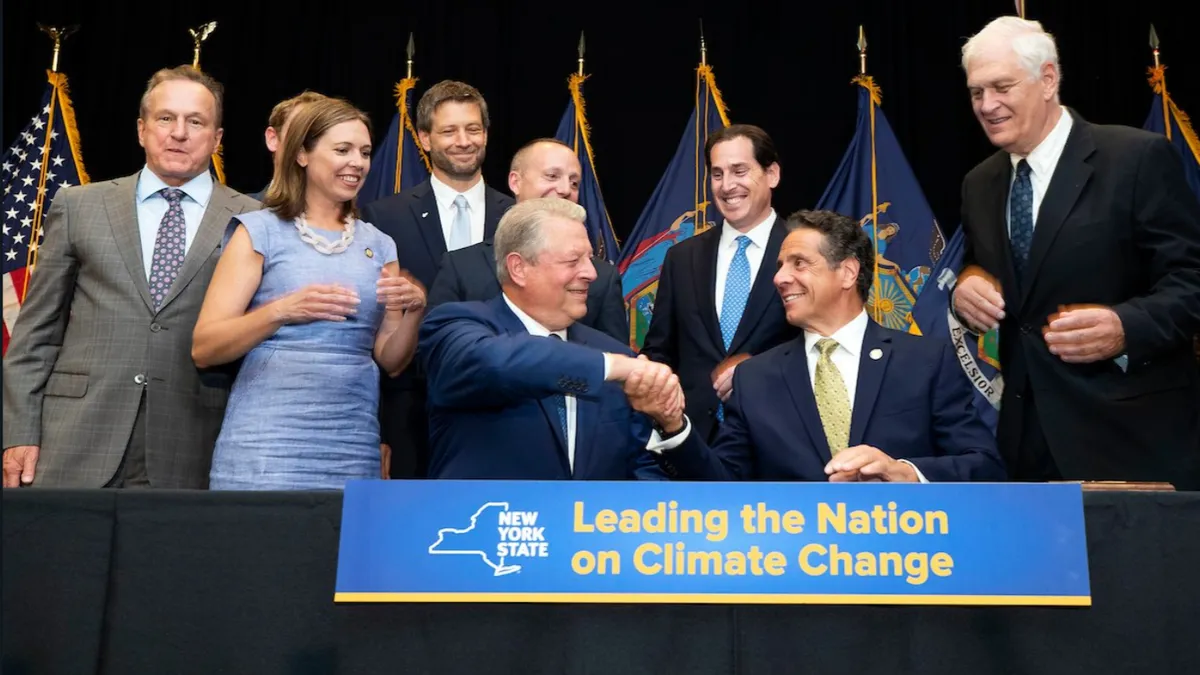Dive Brief:
- In an effort to speed the development of large-scale clean energy resources, New York lawmakers authorized the creation of an Office of Renewable Energy Siting (ORES) and took steps to accelerate transmission investment to move carbon-free electricity to load centers.
- The new siting rules will ensure renewables projects larger than 25 MW can receive approval within a year. Under the current process, siting for these projects takes two to three years, experts say.
- The new office was approved last week as part of New York's 2020-2021 state budget and will be housed within the Department of State. The budget provides funding for up to 25 full-time ORES employees and officials say further resources will be assessed based on need.
Dive Insight:
The current process New York uses to site large renewables was last amended in 2011, and observers say it is cumbersome to navigate because it has no standard set of requirements for projects to meet. The new law calls for establishing regulations and uniform standards to address issues common to large renewables and identifying mitigation measures to address those impacts.
ORES will ensure that complete applications are acted upon within one year, except in the case of certain former commercial and industrial sites, which will be reviewed within six months.
For some projects, meeting the standard conditions could be enough for approval, according to Cullen Howe, senior renewable energy advocate for Natural Resources Defense Council's Climate & Clean Energy Program.
"It could be that every project may have a few specific conditions that it must meet," Howe told Utility Dive. "But it is true that providing more certainty to developers in terms of the kinds of conditions they will have to meet will make it easier and faster for these projects to navigate the process."
The current process is set out under Article 10 of the Public Service Law and has not been updated in almost a decade. As of March 2020, just six projects had been granted certificates of completion and all but one of them were granted a certificate on or after September 2019.
None of the projects are currently in operation and none were granted approval before 2018, Howe said. "The projects aren't getting built fast enough," he said.
The new siting office will primarily address large projects over 25 MW. Projects from 20 MW to 25 MW will have the option to use the current Article 10 process. And smaller renewables will continue to be permitted through the State Environmental Quality Review Act process and must meet local zoning requirements.
New York 'not the only place having trouble getting things built'
New York's renewables-specific siting office is a first for the United States, but could catch the attention of other states, said clean energy observers.
"New York is not the only place having trouble getting things built," Howe said. "There are other states with aggressive renewables mandates. They may look at this and think, 'how can we speed it up?'"
"Streamlining the construction of renewables and the transmission that unlocks them are both needed and welcome developments," American Council on Renewable Energy President and CEO Gregory Wetstone said in an email. "Our hope is that renewable project siting will eventually be improved and streamlined across the entire U.S."
David Gahl, senior director of Northeast state affairs for the Solar Energy Industries Association (SEIA), said the group is not aware of other states currently considering a similar approach. But "other states will likely track New York’s progress and see whether there’s a benefit to this approach," he said.
"The solar industry is eager to see the Office of Renewable Energy Siting set up quickly and the standard permit terms and conditions established as soon as possible," Gahl told Utility Dive.
SEIA will also be monitoring the New York State Energy Research and Development Authority’s (NYSERDA) implementation of sections of the law allowing them to identify sites, acquire site control and permits, and then transfer the development rights to private developers.
"This could provide new opportunities for investment in the state," Gahl said.
Improvements to transmission siting
New York's new siting law also calls for developing a State Power Grid and Study Program to accelerate the planning and build-out of bulk and local transmission and distribution infrastructure, according to NYSERDA.
The law directs the Public Service Commission (PSC) to establish a distribution and local transmission system capital program for each utility in need of local upgrades in their service territory. And it will apply a streamlined siting process, to be completed within nine months, for transmission infrastructure built within existing rights-of-way.
The new law also directs the Department of Public Service to work with NYSERDA, the New York Power Authority, the Long Island Power Authority, the New York ISO and the state's utilities, to identify cost-effective distribution, local and bulk electric system upgrades and file the study with the PSC.
"This landmark act provides for responsible, smart, and swift permitting and siting," Department of Public Service CEO John Rhodes said in a statement.
New York has set one of the most ambitious clean energy agendas in the nation and is targeting 70% renewable electricity by 2030. In March, Gov. Andrew Cuomo revealed details of 21 large-scale solar, wind and storage projects that will bring 1,278 MW of capacity to the upstate region.















